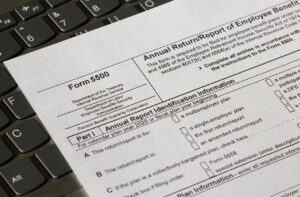
Oh the Times…They are a changing… 2023 Form 5500 Changes
Well, Form 5500s are, that is! For plan years starting on or after January 1, 2023, several changes will be in effect for retirement plans. One of the most publicized changes is a game-changer for some retirement plans needing an independent audit. Before discussing the new rule, let’s refresh our minds with how we count participants now.
The rule for counting participants to determine audit status currently includes employees who are eligible to participate in the plan but do not, employees who are participating or have participated in the plan in the past and have an account balance, former employees who still have a balance in your plan and beneficiaries who have an account balance in your plan. These counts are as of the first day of the plan year. If that number is over 100, you are considered a “large plan filer” and may require an independent audit of your plan by a qualified accounting firm. You also must file a more in-depth, complicated form than a “small plan filer” must file. If the count is between 80 and 120, you can file the same form as you did in the previous year if you want to. So, if you have been filing as a small plan filer, you can defer switching to a large plan filer until your count goes over 120.
For example, let’s say that my company has 125 people eligible to contribute to my retirement plan on January 1, 2022. I also have 20 people who worked for me in the past and have left their balance in my retirement plan. My count is 145 eligible participants for Form 5500 purposes. I will file as a large plan filer for 2022. I will need the more complicated Form 5500 and an independent auditor’s report to attach to my filing.
2023 Form 5500 Changes You Should Know
For the new rule effective January 1, 2023, you only need to look at the number of participants with an account balance on the first day of the plan year. If your plan is brand new, you will look at your count on the last day of the plan year. Furthering my example from above, let’s say that I only have 90 balances in my retirement plan on January 1st of 2023, meaning a good number of my employees are not participating in the plan. I can now file as a small plan filer and skip the audit for 2023. That means I file a less complicated form and will no longer need to incur the cost – or the headache – of an audit.
There is also a transition rule in play for counts between 80 and 120 participants. If you filed as an extensive plan in 2022, you could file as a small filer under this new rule because the number of balances fell under 100. You could also elect to continue to file as a large filer and have a plan audit. This might be prudent if you know this “dip” would only be temporary, and you will have more than 120 balances on January 1st next year. The first year a plan is audited is detailed and more in-depth than in subsequent years. Therefore, it could be worth keeping the audit going for this year if it is only a temporary decrease in counts. However, if you know that you will likely continue to stay under 120 account balances, it would be a cost savings for you to file as a small plan. Overall, the Department of Labor (DOL) estimates that the savings to the retirement plan industry will be about $95 million this year.
Many retirement plans have a provision that allows participants who have terminated from employment but maintain a vested balance in the retirement plan to be forced to decide on their balance and move those funds out of the plan. For 2023, that maximum was $5,000. For 2024, that maximum will increase to $7,000. For example, if my vested account balance is $6,500, my former employer can force me to remove my balance from the plan next year. If I do not, my vested account balance will be rolled into an IRA in my name but separate from the retirement plan. Employing a force-out program with your retirement plan vendors is a great way to clean out your plan and may help you avoid future audits under the new rules.
A few other changes are practical as well. Form 5558s, which allow for Form 5500s to be filed under extensions, can now be electronically submitted, allowing a more streamlined process. The DOL and IRS have jointly created consolidated reporting options for a new type of entity called a Defined Contribution Retirement Group or DCG. This group of plans has all their assets in a single trust with the same plan administrators, trustees, fiduciaries, and investments. This will be helpful to simplify reporting for multiple employer plans (MEPs) and pooled employer plans (PEPs).
Lastly, the DOL will collect more data on forms, starting with the revised forms. There will now be specific questions about the compliance testing your plan may have to run. The form will also ask you to report if you use a pre-approved plan document and gather some information about what document you are currently using. Finally, for large plan filers, there will be additional breakdowns of the fees paid by the plan.ML&R Wealth Management is here to assist you with your Form 5500s as a part of our third-party administration services. For more information about these changes or our services, please contact our team at retirement@mlrpc.com.



